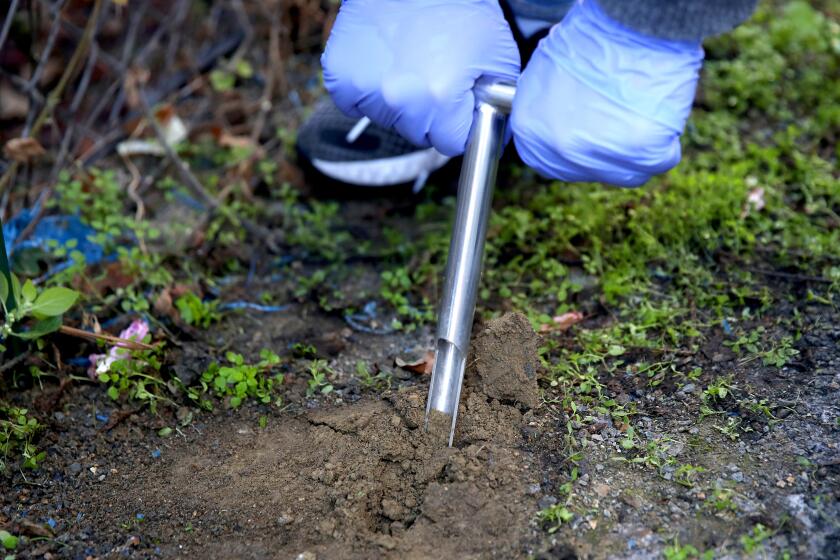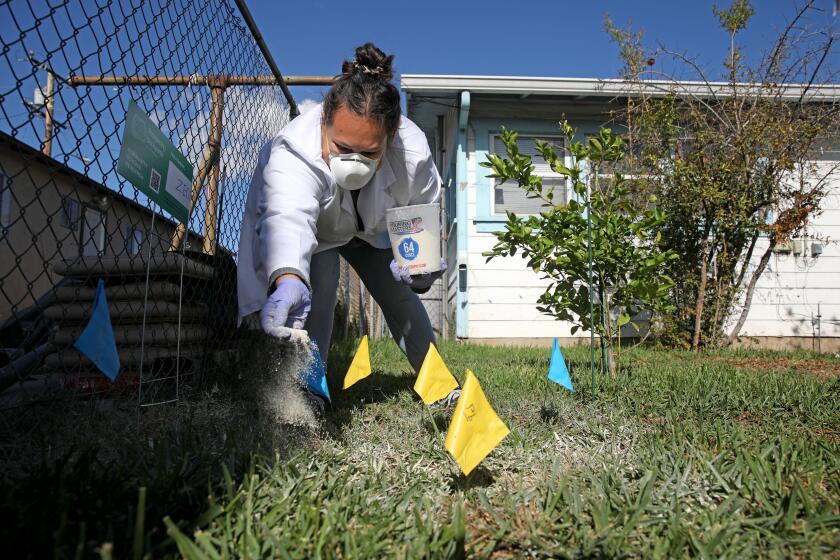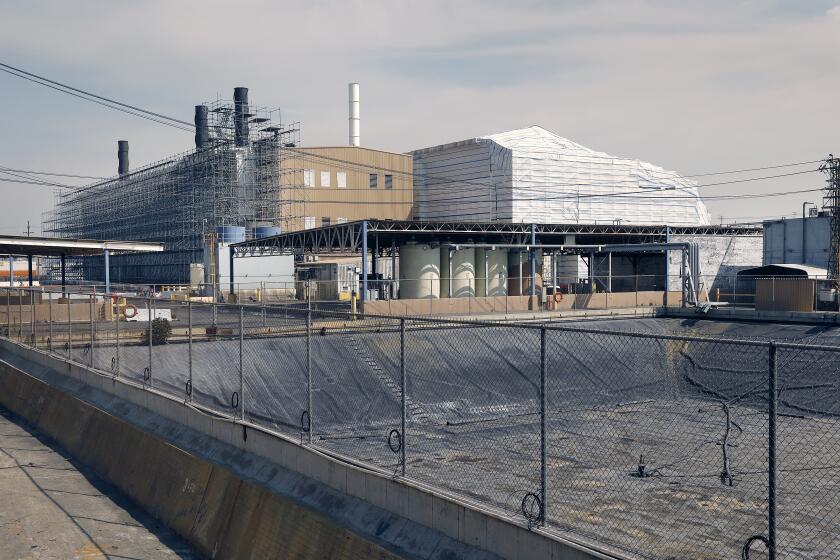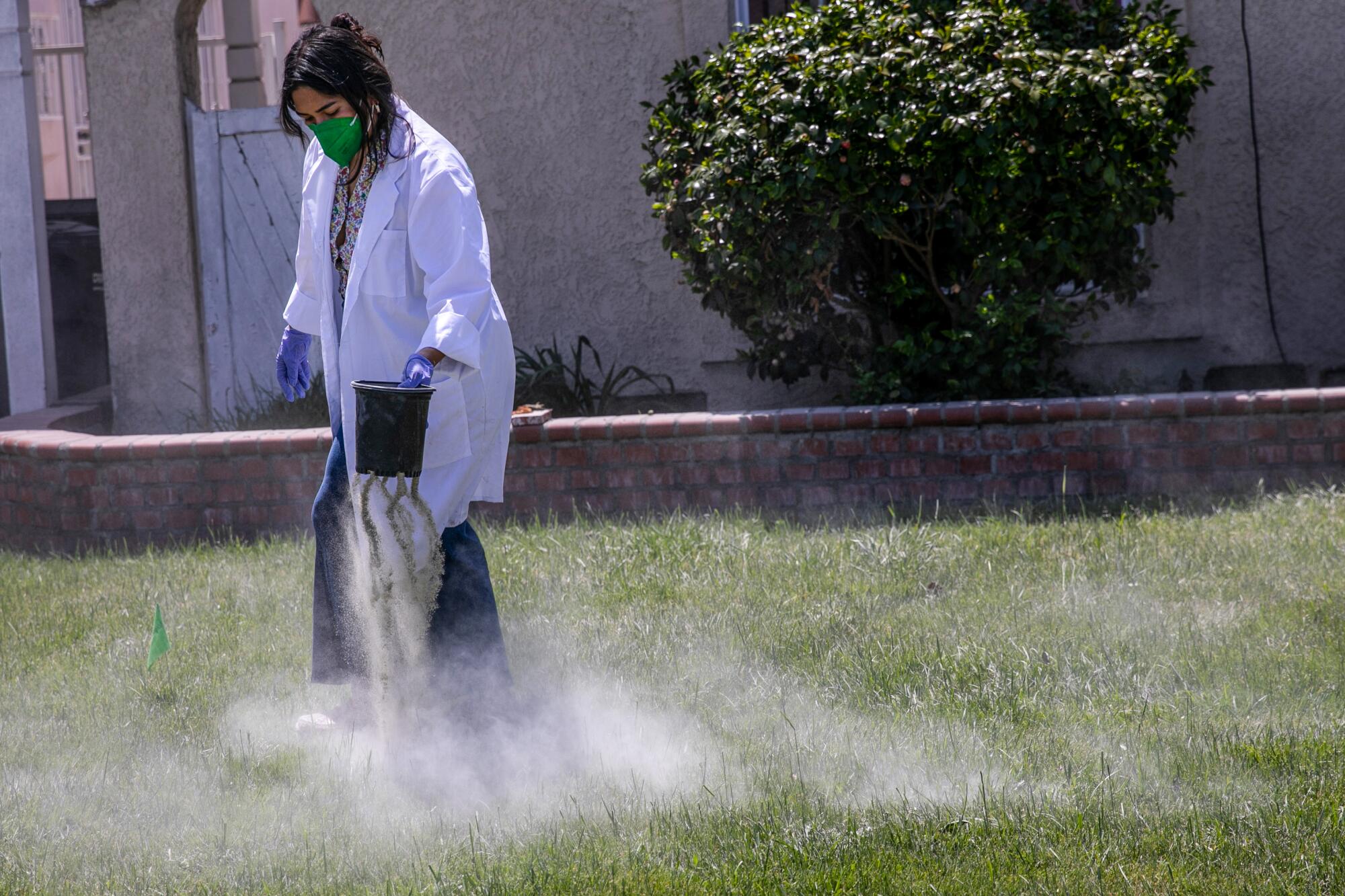
Under the watchful eyes of neighbors, scientists in white lab coats knelt to spread a flour-like mineral over a lawn in Huntington Park.
The dusting of zeolite doesn’t take long, but it could be key to mitigating a disaster that has festered for decades across southeast Los Angeles County: lead contamination in the soil around thousands of homes.
“It’s 20 minutes of work, and it’s a lifetime of lead remediation for a person’s backyard,” said Aaron Celestian, mineral sciences curator with the Natural History Museum of Los Angeles County and lead scientist with the Prospering Backyards project.
Zeolite is naturally adsorbent, meaning it can collect other substances on its surface. The porous mineral, often used in agricultural products, detergents and cat litters, acts like a sponge, trapping lead atoms when it’s sprinkled on the contaminated lawns. That stops the lead from seeping back up into the air or breaking away into the soil, rendering it safe for plants, animals and humans, Celestian said.
For nearly a century, the now-shuttered Exide Technologies battery recycling plant in Vernon dispersed lead and other toxins across neighborhoods home to predominantly Latino and low-income residents. According to the California Department of Toxic Substances Control, as many as 10,000 properties near the plant could have been affected by the pollution pouring out of Exide.
California has requested the U.S. Environmental Protection Agency list the area around the plant as a Superfund site to pay for the cleanup, because Exide abandoned the plant in 2020. The $750-million remediation effort, which began six years ago, is the largest and most expensive environmental cleanup in state history.
Numerous homes that underwent remediation have been left with lead concentrations in excess of state health standards, according to USC researchers.
Though the state toxics agency said it has cleaned thousands of properties, including homes, schools, parks and day-care centers, a Times investigation this year found that numerous properties remediated at great cost to state taxpayers have been left with concentrations of lead in their yards in excess of state health standards.
What’s more, the cleanup zone recognized by the state extends to a radius of only about 1.7 miles around the former Exide plant, leaving out many properties with concerning levels of lead contamination.
Michelle Jimenez’s home in Huntington Park, about 2.5 miles from the plant, is among them.
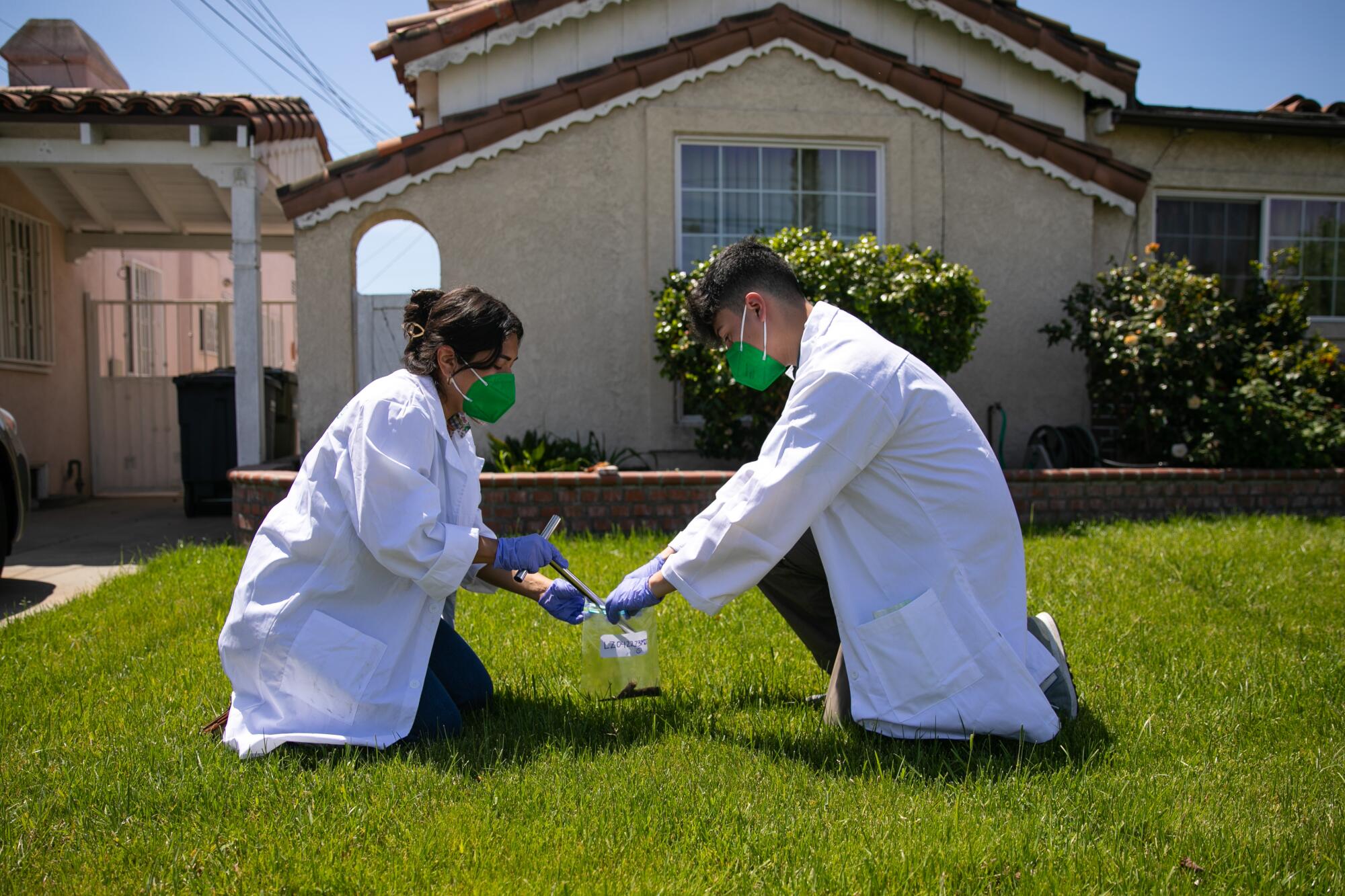
Soil samples taken at her home show lead levels several times higher than what California considers safe, according to Prospering Backyards, which is part of a long-term research project with the Natural History Museum and made up of scientists, artists, activists and community members developing an alternative method to reduce lead exposure in the hardest-hit communities.
Growing up in Huntington Park, the 27-year-old Jimenez has been aware of the toxic history behind the Exide plant. Her father, Luis Jimenez, has Parkinson’s, anxiety and heart issues she attributes to the neighborhood’s exposure to industrial waste. He’s lived in Huntington Park since the early 1980s.
Children who grew up near the Exide plant have elevated levels of lead in their teeth and blood, according to a 2019 study from the Keck School of Medicine of USC.
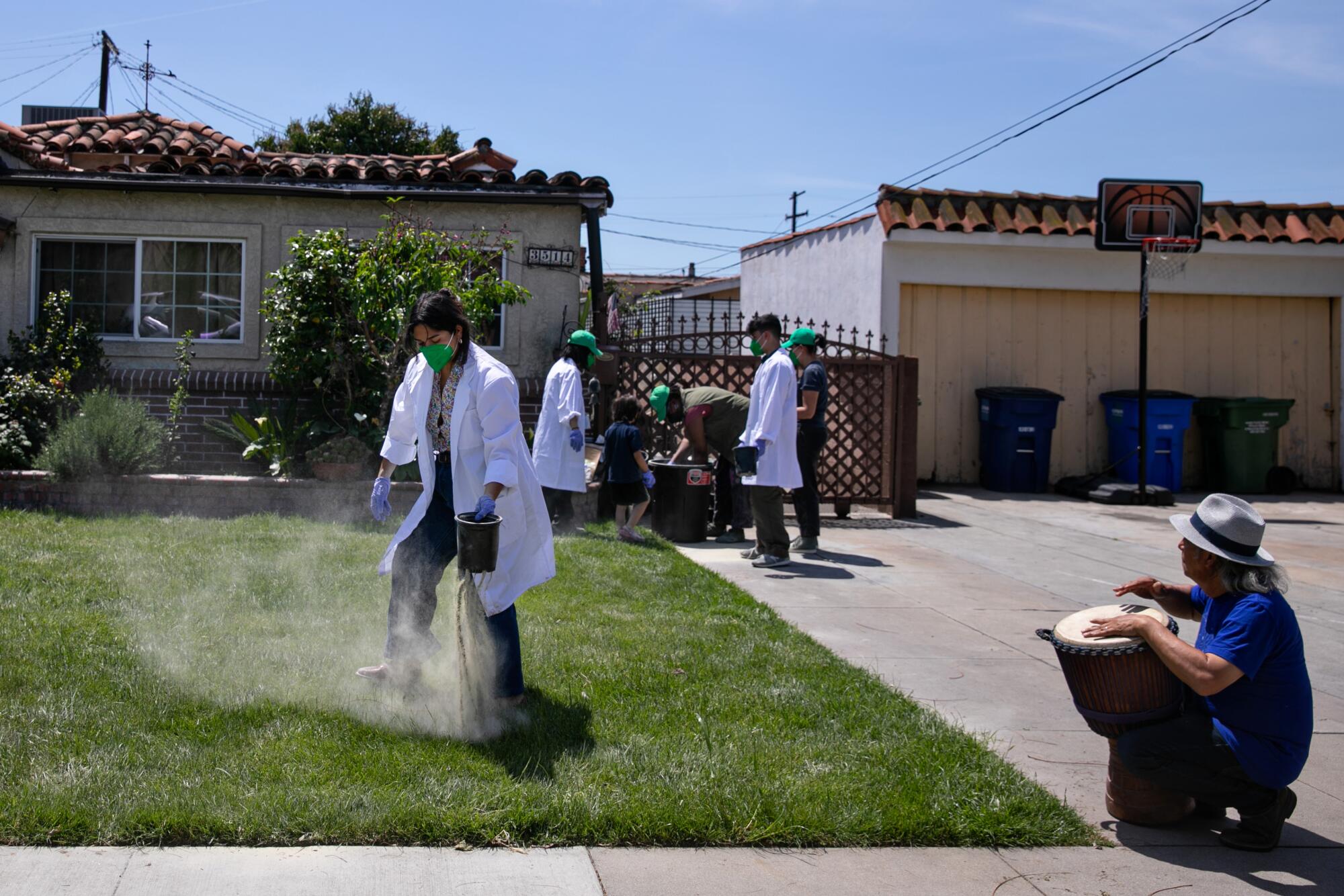
“I’ve known that my community has been exposed to environmental injustices for so long in our soil, water and air,” Jimenez said. “I’m so desensitized.”
On a recent April morning, Jimenez and community scientists with Prospering Backyards donned their white lab coats and took soil samples from her frontyard.
After they took the samples, the scientists applied the zeolite, which billowed down to the soil in a yellow cloud, and watered the lawn with a hose. Maru Garcia, project lead with Prospering Backyards, placed green flags in the soil where samples were taken.
Many community members and advocates were unsatisfied with the pledge, with one resident dismissing it as ‘another DTSC world apology tour.’
Jimenez’s parents watched from the side. They arrived in California in the 1970s from Jalisco, Mexico, and raised five children in the Huntington Park home.
After the zeolite was applied, Jimenez’s mother, Micaela Jimenez, told her daughter she thought her plants and flowers in the backyard would not have been affected by the lead contamination.
Garcia chimed in to tell them about the high amounts of lead concentration in soil samples taken from their frontyard. It’s likely there is more lead in the backyard, Garcia said, because toxins from the Exide plant were airborne when they descended on the neighborhood.
“The idea is we want to help more people to become aware of the situation through education, and this is also how to heal our soil,” Garcia said in Spanish. “It is not through just information, but through coming to the houses to offer a method that we could develop together to do this remediation.”
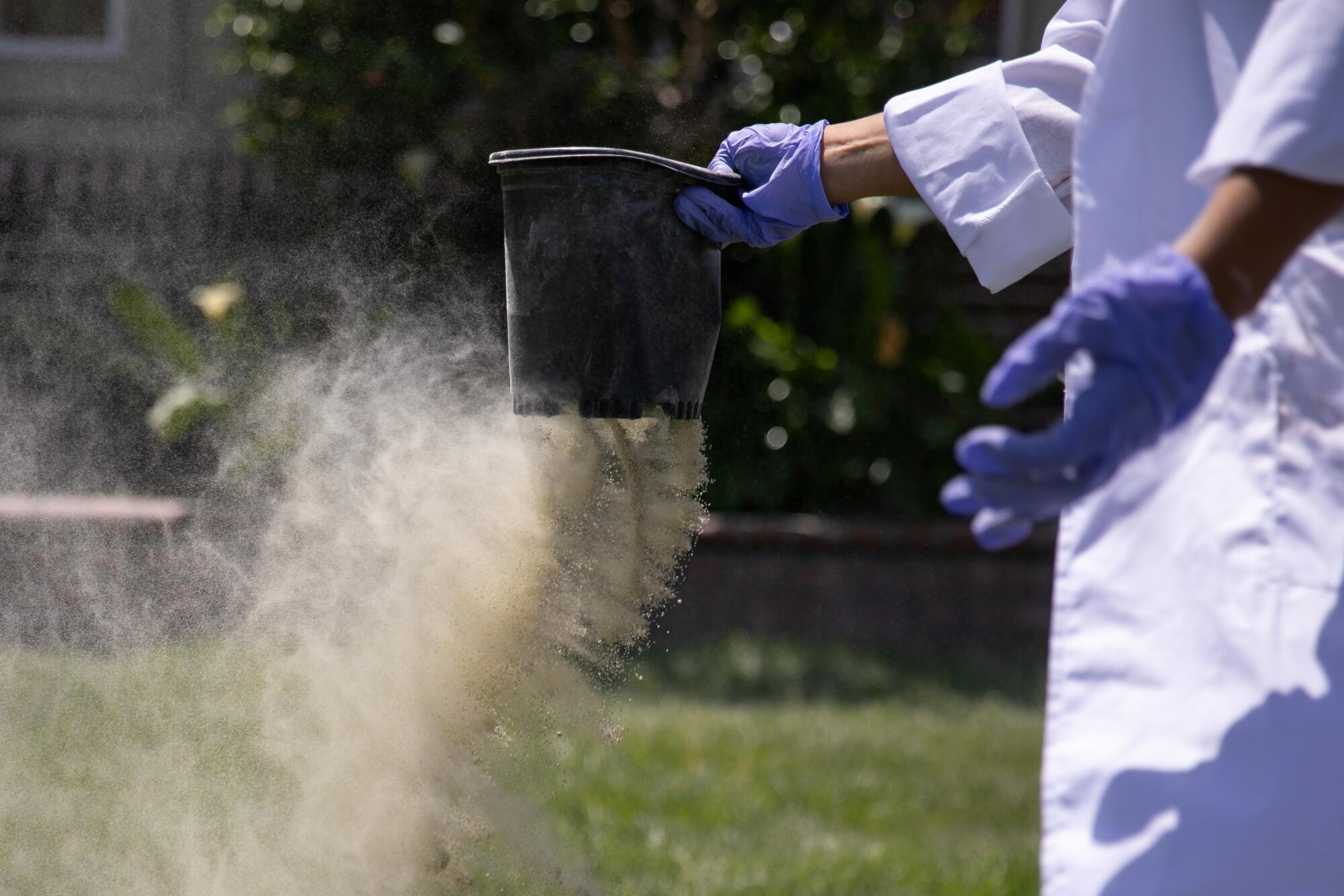
The zeolite has been deployed in 15 backyards across multiple neighborhoods in an ongoing experiment that started in December, Garcia said. But research into the project began in 2021, when the Self Help Graphics & Art gallery and community space in Boyle Heights was selected to receive a grant from the Getty Foundation to participate in “Pacific Standard Time: Art x Science x L.A.” in 2024.
The exhibit, “Sinks: Places We Call Home,” will examine the communities around a former petroleum storage facility known as the Athens Tank Farm in Willowbrook as well as the neighborhoods around the Exide plant. The exhibit’s title alludes to the idea that these communities have often served as reservoirs or sinks for industrial waste, curators said.
“I’m using this exhibition to elevate this topic of lead contamination,” said Marvella Muro, director of artistic programs and education at Self Help Graphics.
The project is at the intersection of social justice and art, with the voices of the community at the forefront, Muro said. Prospering Backyards invited percussionist Rude Calderón to play a djembe drum, because they feel the process is a form of healing for the earth.
Muro thinks the project will serve as a reminder that this problem is still unfolding.
“It’s about understanding the facts behind the contamination and why the obstacles to cleaning them up are so big. They’re so much bigger than one person can handle,” Muro said.
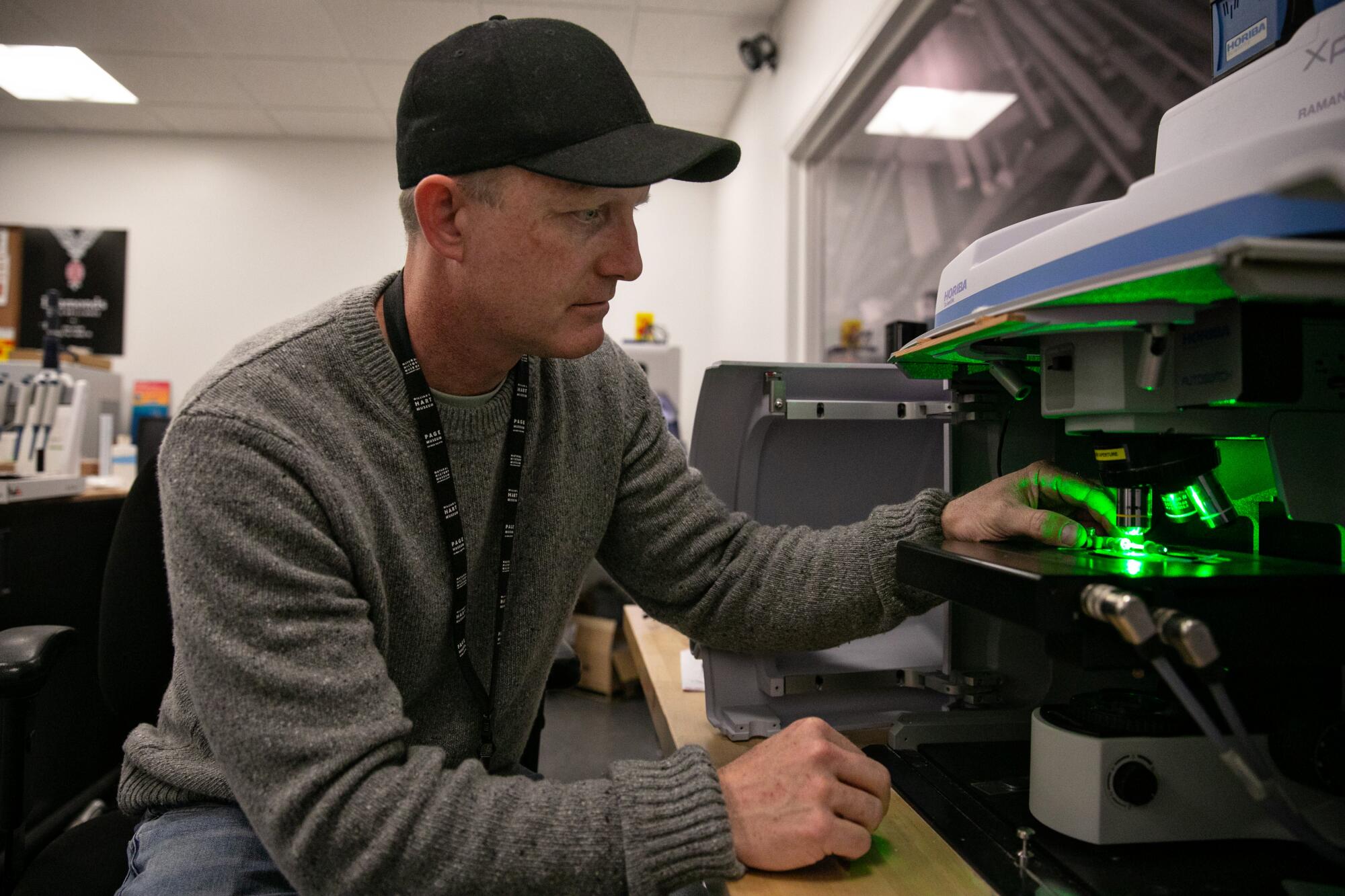
It has taken roughly two years for researchers with Prospering Backyards to train residents on how to become community scientists and take soil samples from yards. There was also a bit of trial and error to determine which type of zeolite would be best to soak up lead atoms, Celestian said.
At the Natural History Museum, Celestian pointed to several puck-shaped soil samples taken from yards across Los Angeles County, explaining how each sample is examined to determine how effective the zeolite is at pulling out the lead.
Zeolite clinoptilolite, the type of mineral used in the project, is marketed for both human consumption and even for pets and livestock, Celestian said. It’s a naturally growing mineral that if digested does not break down at the molecular level and simply passes through the body.
Other forms of zeolite, such as the fibrous erionite, can cause some forms of cancer when inhaled, according to the Memorial Sloan Kettering Cancer Center. But that is a different type of mineral from the one used in the Southern California backyard experiment, Celestian said.
ZeoSource, the commercial name of the zeolite mineral used by Prospering Backyards, is used as artificial turf infill, as well as for agricultural purposes. The same type of zeolite minerals are also used in agricultural settings to reduce heavy metals in plants and as an additive to livestock feed for pigs, lambs and calves, according to a recent study published in Agronomy Journal.
Celestian said the mineral used in the project had been “well studied and scrutinized” and had “a long history of demonstrated scientific research to show how safe and effective they are in people, plants and animals.”
Researchers with Prospering Backyards see the mineral’s potential as an alternative mode to addressing the lead toxins in the soil.
“The hope is that this will be a mode that can be adopted by the county. Even if it isn’t the final strategy for lead remediation, it’s a way to keep lead out of people’s bodies,” Celestian said.
The current process to clean a lawn contaminated with lead is expensive and time-consuming. California has only enough funding to clean about 5,600 properties around the Exide plant, according to a Department of Toxic Substances Control spokesperson. The state has requested federal funding, but the toxics agency still only recognizes the roughly 1.7-mile radius around the former Exide plant as the cleanup zone.
The EPA says it is working with the state to collect data to determine if a Superfund status could be considered. The federal agency will begin collecting soil samples in May through August, according to a department spokesperson, and the data will be evaluated later this year.
Federal officials visited the site earlier this year and met with local residents, adding that the EPA “understands and acknowledges the negative impacts Exide operations and the subsequent bankruptcy have had on the surrounding community, which is historically overburdened and underserved, and we’ll ensure these impacts are documented during the process of considering a Superfund listing.”
As many as 10,000 properties within 1.7 miles of a shuttered battery recycling plant may have been contaminated. Check your property’s cleanup status.
Homes that have been tested by the state have elevated levels, meaning it’s unclear where the zone of toxicity ends, said Mark Lopez, a community organizer for East Yard Communities for Environmental Justice. The group has advocated for a more vigorous cleanup and for the state to expand the toxic cleanup zone to a radius of at least 4.5 miles.
As an activist, Lopez has been pushing for more accountability from California lawmakers to respond to the Exide cleanup. East Yard Communities is working in a similar vein to Prospering Backyards in educating residents about the lead in the yards.
Currently, Lopez is working with the Get the Lead Out research project with Occidental College and the Keck School of Medicine at USC. Project volunteers are meeting with residents, taking soil samples and providing new information to residents who may have not known they were moving into a toxic mess.
The project is also teaching people how to reduce their exposure to the toxins in the ground by making sure they wash their hands, leave their shoes outside their homes so they don’t track in contaminated soil and recognize all the resources that are available through the county, like blood testing.
“The reality is that the state’s not going to come and clean up within the next couple of years,” Lopez said. “So it’s something that we’re having to do on a more community level.”
More to Read
Sign up for Essential California
The most important California stories and recommendations in your inbox every morning.
You may occasionally receive promotional content from the Los Angeles Times.
